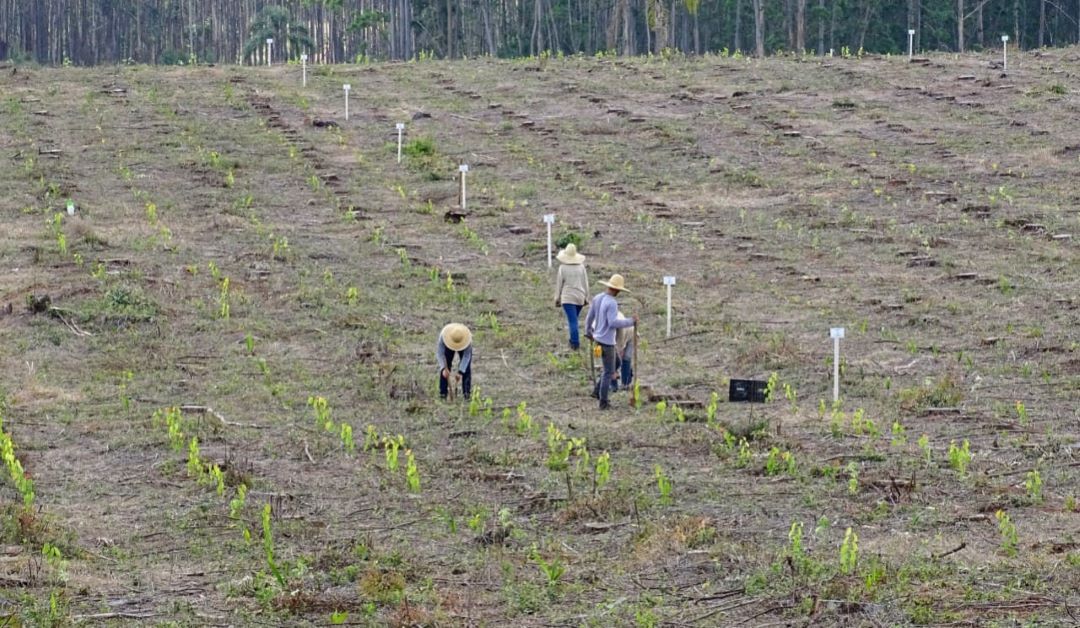MataDIV (Brazil)
MataDIV is a tree diversity experiment that aims to improve our understanding of the functioning of restored forests in the highly-diverse tropical Atlantic forest biome (Mata Atlântica) under climate change, and to provide scientific bases for the design of forest restoration guidelines. MataDIV was planted on November/December 2019, in the Itatinga research station (University of São Paulo / ESALQ), southern Brazil, in a former Eucalyptus coppice parcel. The experiment focuses on six native species of great restoration and/or silvicultural interest, which display contrasted ecological strategy and are widely distributed in the Mata Atlântica.
The MataDIV experiment is combined with an observational site (MataFLUX, installed in 2020) that measures the water, carbon and energy cycling of a 6-species mixture restoration planting using the Eddy-covariance technique and soil water monitoring. The same 6-species pool is studied in MataDIV and MataFLUX.
The MataDIV/MataFLUX project results from a collaboration between the University of São Paulo / ESALQ (LASTROP - Tropical silviculture Lab) and the Cirad (the French agricultural research and international cooperation organization, Eco&Sols Research unit).
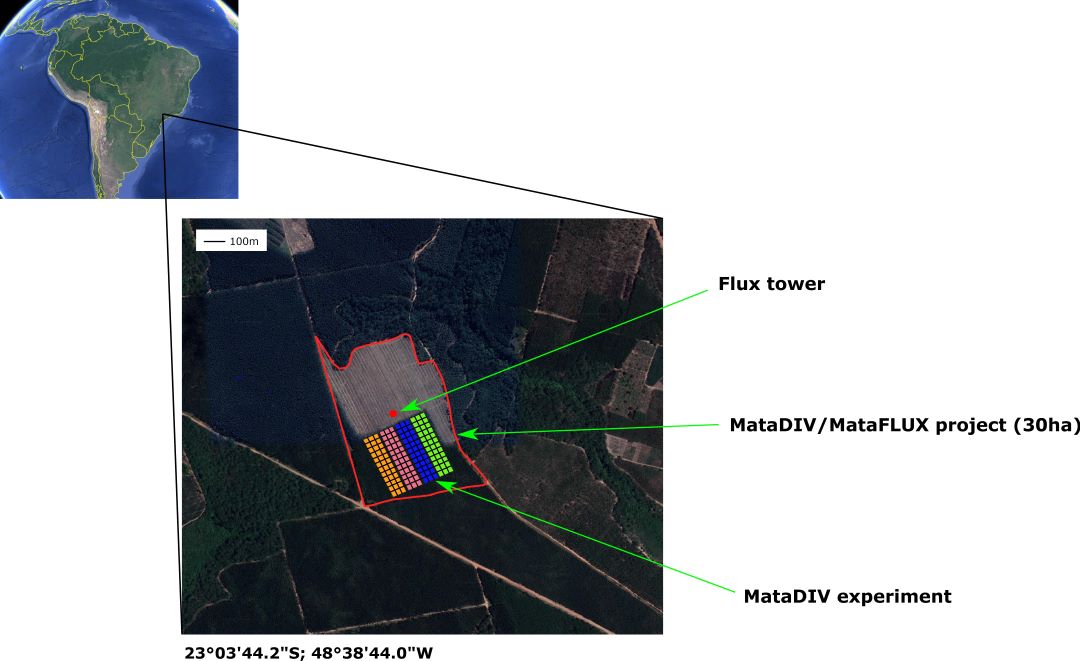
Design
MataDIV consists of 144 plots (20 m x 23m, 100 trees), in a randomized split-plot block design. The experiment focuses on six species (but includes “high diversity” 20-species reference plots). Three variables are manipulated:
- Species richness (six monocultures, four 3-species mixtures, one 6-species mixture and one 20-species mixture “high diversity” reference level). All of the six main species are equally represented at each diversity level (“broken-stick” design). In total 12 different compositions are included.
- Fertilization (no fertilization versus N, P, K, Ca, Mg fertilization)
- Water availability (normal rainfall versus throughfall exclusion). This treatment will be implemented ~1 year after planting.
Fertilization and water availability treatments are not fully crossed. The following combinations are studied: “fertilization and normal rainfall”, “fertilization and throughfall exclusion”, “no fertilization and normal rainfall”. The experiment includes four replicated blocks, with 36 plots per blocks, in a total area of ~8ha.
The studied species are Cariniana estrellensis (CE), Cecropia pachystachya (CP), Guazuma ulmifolia (GU), Hymenaea courbaril (HC), Handroanthus impetigionosus (HI), Syagrus romanzoffiana (SR). Species can be categorised in three functional groups, from acquisitive (pioneer), to conservative (late-successional) species.
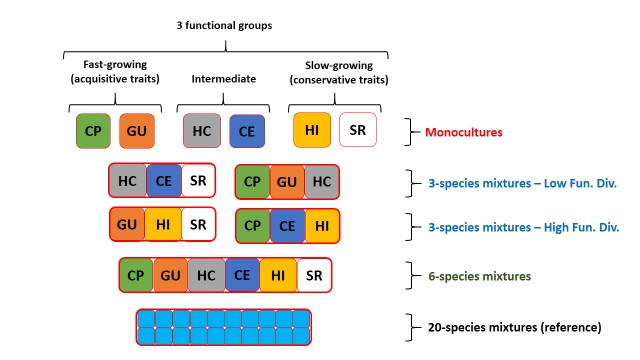
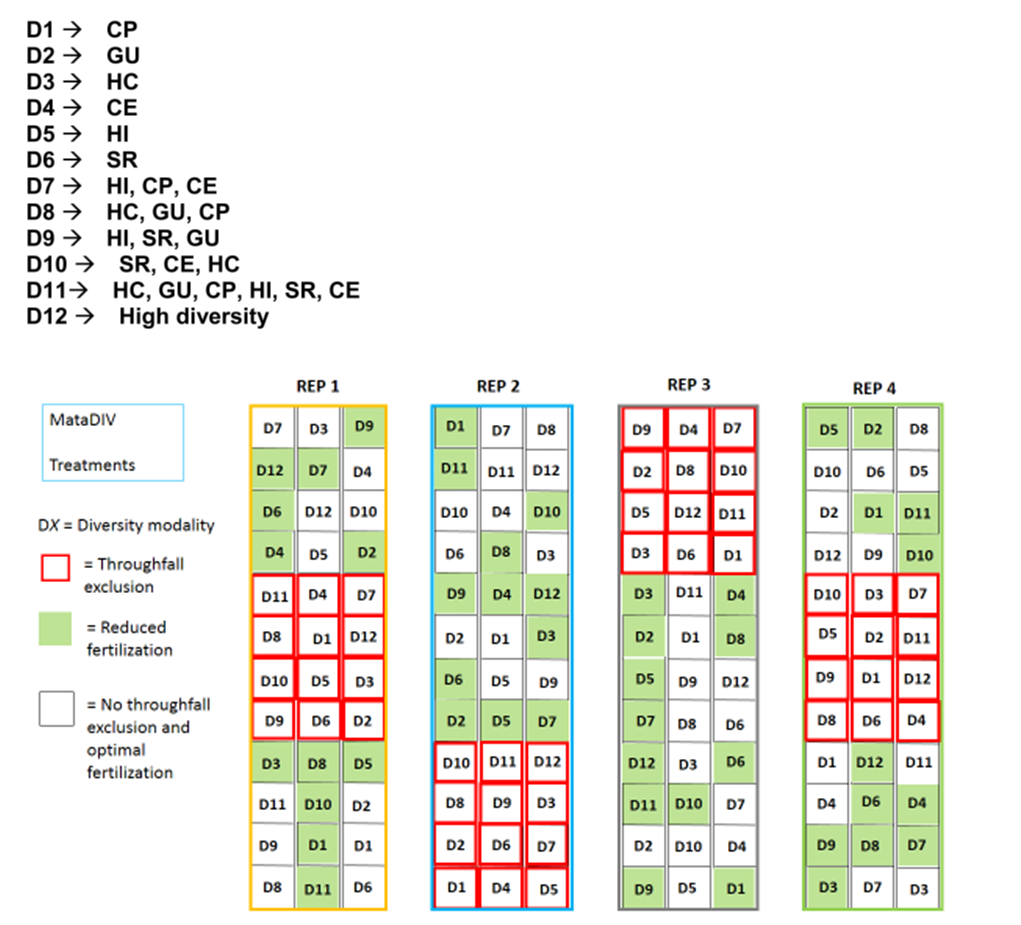
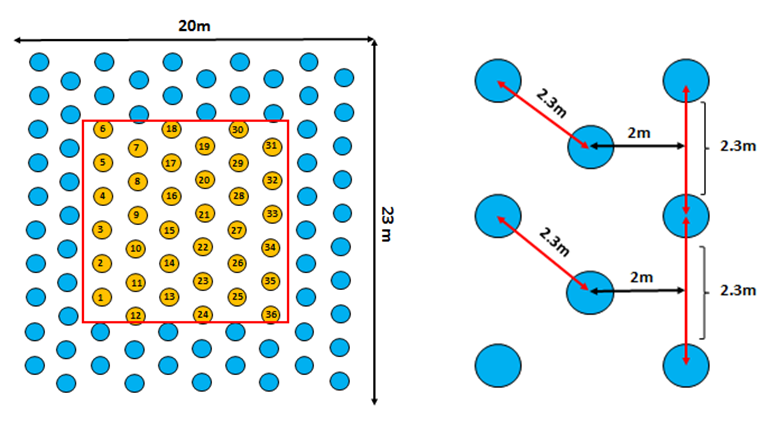
Site characteristics
| MataDIV (Brazil) | |
|---|---|
| Country | Brazil |
| Biome | tropical |
| Latitude | -23.06 |
| Longitude | -48.65 |
| Soil type | Deep Ferralsol |
| Former land use | Eucalyptus commercial coppice |
| Altitude | 820m |
| Design | Constrained random design maximizing neighbourhood species richness in mixtures |
| Plot shape | rectangular |
| Plot size (m^2) | 460 m² |
| Plant distance (m) | 2.3 |
| Number of trees planted | 14 400 |
| Planting date | 2019 |
| Diversity variables | species richness functional diversity |
| Diversity gradient | 1, 3, 6 sp 3 functional groups |
| Size species pool | 6 sp + 20 sp in the reference high-diversity plots |
| Species pool | Cariniana estrellensis Cecropia pachystachya Guazuma ulmifolia Hymenaea courbaril Handroanthus impetiginosus Syagrus romanzoffiana |
| Contact person | Joannès Guillemot Pedro Brancalion Agnès Robin |
| Joannès Guillemot Pedro Brancalion Agnès Robin links niet beschikbaar |
Research
The MataDIV experiment will be used to conduct research on the biological mechanisms driving biodiversity - Ecosystem functioning relationship, with a particular focus on tree - soil interactions and carbon, water, nutrient and energy cycling.
Extra information
For more information on the MataDIV experiment, send an e-mail to the contact persons or explore the publications that utilized data from this experiment.
Research papers
- Depauw L, De Lombaerde E, Dhiedt E, Blondeel H, Abdala-Roberts L, Auge H, Barsoum N, Bauhus J, Chu C, Damtew A, Eisenhauer N, V. Fagundes M, Ganade G, Gendreau-Berthiaume B, Godbold D, Gravel D, Guillemot J, Hajek P, Hector A, Hérault B, Jactel H, Koricheva J, Kreft H, Liu X, Mereu S, Messier C, Muys B, Nock CA, Paquette A, Parker JD, Parker WC, Paterno, GB, Perring MP, Ponette Q, Potvin C, Reich PB, Rewald B, Scherer-Lorenzen M, Schnabel F, Sousa-Silva R, Weih M, Clara Zemp D, Verheyen K, Baeten L 2024 Enhancing Tree Performance Through Species Mixing: Review of a Quarter-Century of TreeDivNet Experiments Reveals Research Gaps and Practical Insights. Current Forestry Reports - https://doi.org/10.1007/s40725-023-00208-y
- FAO 2023 Towards more resilient and diverse planted forests. Unasylva (254)74: 2031/1. Rome. https://doi. org/10.4060/cc8584en
- Messier C, Bauhus J, Sousa-Silva R, Auge H, Baeten L, Barsoum N, Bruelheide H, Caldwell B, Cavender-Bares J, Dhiedt E, Eisenhauer N, Ganade G, Gravel D, Guillemot J, Hall JS, Hector A, Hérault B, Jactel H, Koricheva J, Kreft H, Mereu S, Muys B, Nock CA, Paquette A, Parker JD, Perring MP, Ponette Q, Potvin C, Reich PB, Scherer-Lorenzen M, Schnabel F, Verheyen K, Weih M, Wollni M, Zemp DC 2021 For the sake of resilience and multifunctionality, let’s diversify planted forests! Conservation Letters e12829 - https://doi.org/10.1111/conl.12829
